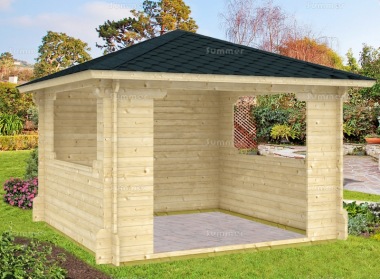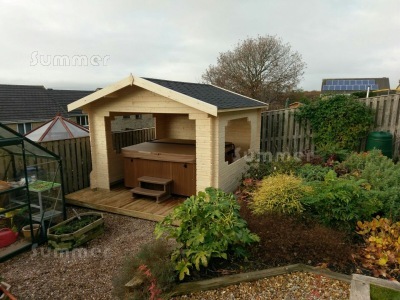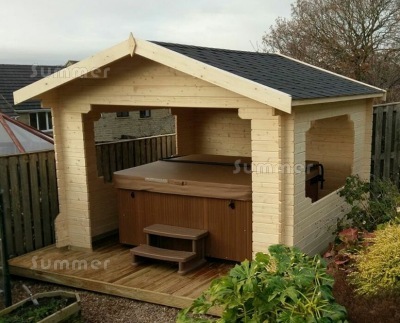Click this messge to hide it.
- All timber used in the construction of these log cabin gazebos originates from sustainable forests
- Interlocking 40mm thick tongued and grooved wall logs
- All logs double grooved for superior draughtproofing
- Strong 18mm thick tongued and grooved roof boards
- Pressure treated 45mm x 70mm foundation beams (lifetime preservative treatment)
- Substantial 4"x2" roof purlins (finished size 40x94mm)
- Chamferred top wall logs
- Attractive and functional metal ridge cover in powder coated steel
- Timber storm bars
- Door opening width approximately 1.79m (5'10")
- Side aperture width approximately 2.2m (7'3")
- Approximate roof size 3.3m wide x 3.3m long (10'10" x 10'10")
- Overall external cabin size 3.2m wide x 3.2m long (10'6" x 10'6") including the widest bottom logs
- External cabin size 3.0m wide x 3.0m long (9'10" x 9'10") excluding the wider bottom logs
- Minimum base size 2.8m wide x 2.8m long (9'2" x 9'2")
- Internal cabin size approximately 2.72m wide x 2.72m long (8'11" x 8'11")
- Ridge height 2.95m (9'8")
- Eaves height 2.28m (7'6")
A HOT TUB COVER OR A HEAVY DUTY GAZEBO: This log cabin can be used to cover or enclose a hot tub or spa. Smaller hot tubs will pass through the door opening. Larger hot tubs are positioned before the cabin is installed. There is enough space inside to comfortably accommodate even a large hot tub. This versatile cabin is also popular as a garden gazebo which can be used as a shady retreat in the summer or as a store for garden furniture and toys in winter.
SCANDINAVIAN REDWOOD OR WHITEWOOD: The most widely used timber in the UK for years, Scandinavian Redwood and Whitewood grow in the well managed forests of Scandinavia and the coldest parts of Northern Europe. The cold climate ensures slow growth. The growth rings are much closer together than faster growing trees from warmer climates. As a result the timber is heavy and durable with a close grain pattern. The wood is seasoned and kiln dried to achieve the correct moisture content before it is machined. Redwood and Whitewood are so similar in appearance and performance that it is difficult to tell the difference. Both are classified as slightly durable and treatment is required for outside use. The forests of Scandinavia and Northern Europe have been responsibly managed on a sustainable basis for centuries so Scandinavian Redwood or Whitewood is an enviromentally friendly choice.
NATURAL WOOD: First, high grade timber is dried in kilns until it reaches the optimum moisture content, then it is planed smooth and machined into tongued and grooved logs and boards. Next the logs are precisely machined at the ends to ensure a precise fit. Finally, each cabin is carefully packed and wrapped. When you unwrap it the wood is untreated. We recommend treating it only after the cabin has been successfully installed and ideally within a week or two. Treating the logs before fitting may cause the wood to swell up and the logs may not fit together correctly. If you are fitting your cabin in a restricted space where future access will be difficult you can stain the logs during installation by reaching down a few logs at a time as you fit them.
FULLY INTERLOCKING LOG CORNERS: These traditionally made log cabins feature interlocking corner logs. Each wall log is precisely machined and notched out to ensure a strong and weatherproof joint. The first log is laid at the bottom and the rest slot into each other, working upwards one log at a time. No screws or nails are required which makes installation easier and also allows for timber movement. The finished corner assembly is not only immensely strong but also weatherproof and draughtproof. If possible cabins with interlocking logs should be treated after assembly. Treating the logs on site before fitting requires considerable care. If swollen the precision milled joints may not slot together.
WEATHERPROOF DOUBLE GROOVED LOGS: Thinner wall logs feature a single tongue and groove but thicker logs feature a double tongue and groove. The double tongue and groove provides a stronger and more weatherproof joint. Thicker logs also provide improved insulation.
CHAMFERRED TOP WALL LOGS: This high specification building features a subtle quality feature. The top log in each side wall is chamferred to the same angle as the roof slope. This little detail provides much improved insulation and draughtproofing. It also provides a much neater internal appearance and the roof boards are easier to fix. This simple design feature eliminates an obvious cold spot. The benefits of this feature are magnified if roof insulation is specified.
WEATHERPROOF METAL RIDGE COVER: This log cabin features a one-piece prefabricated metal ridge cover which fits over the highest part of the roof. With an attractive and durable powder coated finish the ridge cover provides a neat finish but it also makes the finished roof more weatherproof. Installation is also quicker and easier.
STORM BARS: Storm bars are an important quality feature. One obvious benefit is that storm bars help to protect your log cabin from wind damage. In addition, by clamping the logs together storm bars make the joints more weatherproof and reduce any bowing or twisting of the logs. The storm bars are easily fitted at each corner to hold the individual logs together tight. This counters the impact of strong winds. This feature is especially useful if the cabin has a large roof overhang which is exposed to the wind. Many log cabins do not include any storm bars. These timber storm bars feature elongated fixing holes to allow for timber movement. The bolts are easily accessible after installation so they can be tightened or loosened as required to allow for any timber movement.
VIDEOS: Any videos displayed on this page may be generic and not accurate in every detail although the fundamental nature of the product is portrayed honestly. Some details may differ between buildings. Please refer to the bullet points above for an accurate description of this particular building.
DEPTH AND WIDTH: Sizes are sometimes rounded to the nearest nominal size for ease of reading but the correct external wall sizes are listed alongside the price. The first dimension listed is the width and the second dimension is the depth. The width refers to the front and rear walls including the door wall. The depth refers to the side walls. The sizes listed are the external wall sizes. These sizes do not include the roof overhang. Many other suppliers quote the overall roof size which is much larger. All sizes are approximate.
































